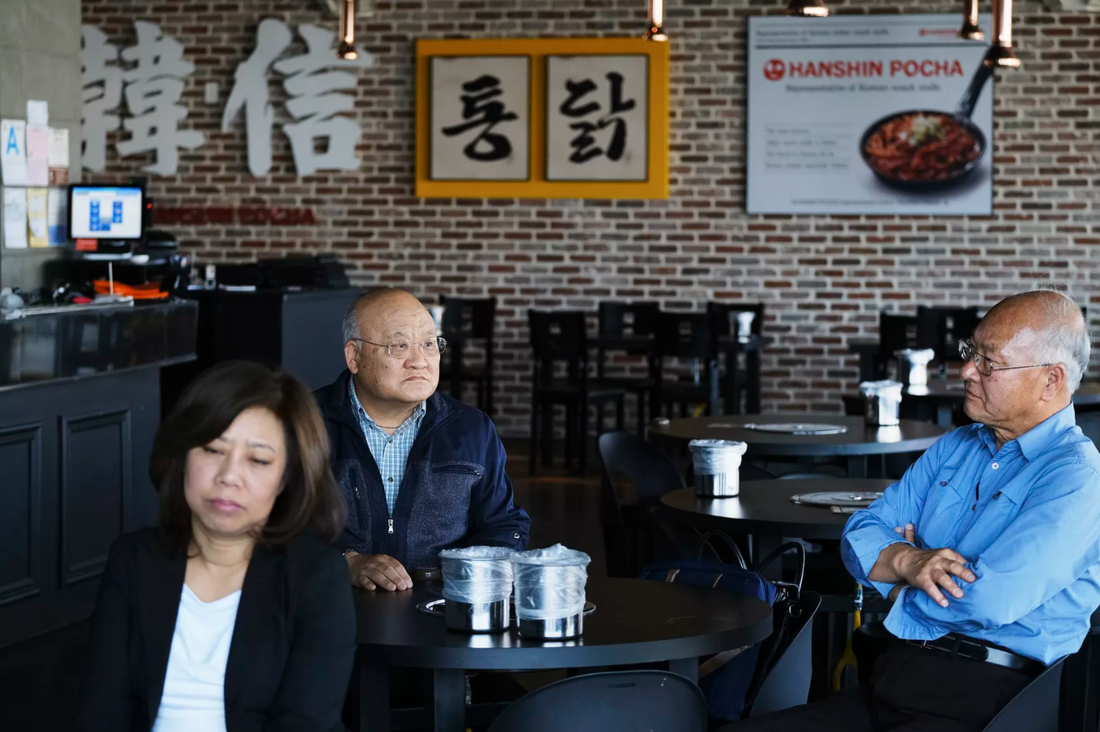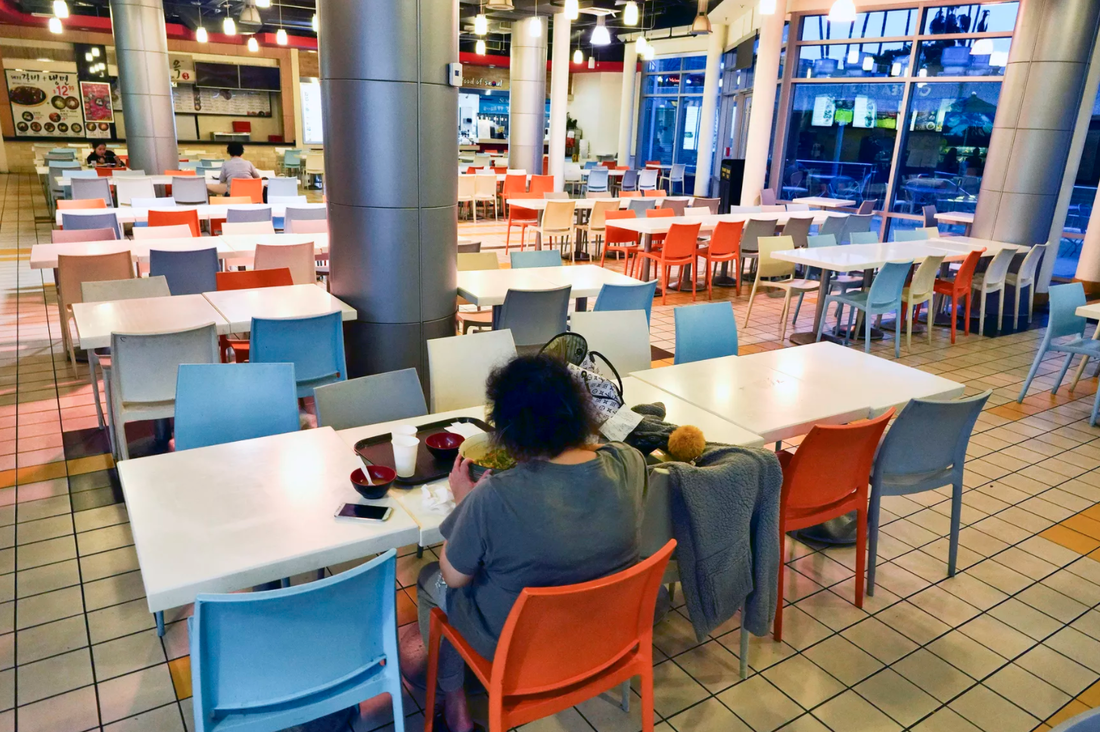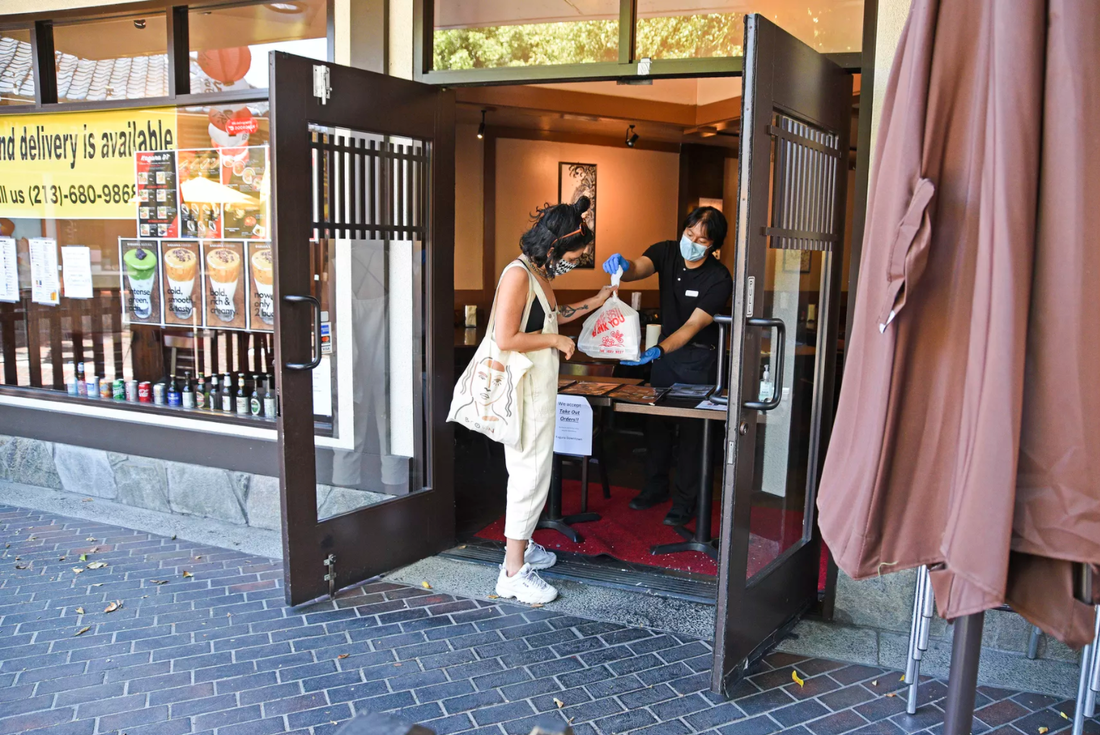|
Asian American businesses are besieged by racism that leaves them open to attacks and by economic stereotypes that render them forgotten. Roy Kim knew back in December that something had changed. The operating manager of Dong Il Jang, the 41-year-old restaurant in Los Angeles’s Koreatown neighborhood and one of the city’s longest-running Korean restaurants, was noticing declining clientele, beginning with their Chinese regulars. The profits he’d expected the business to make during the Christmas rush never materialized, and the loss set the tenor for what was to come. As news of the coronavirus began to radiate out from China and dominate the news cycle, fear of its spread in the US followed. Koreatown’s small businesses, like in other Asian enclaves across the country, began to feel the economic fallout at least a month before shutdown orders began in March, as associations between Asians and contagion began to foment. Alongside media outlets singling out Asians as the “face” of the coronavirus in early coverage, the use of racist terms like “China virus” has also grown, further linking the virus to anything and anyone with Chinese identity — and, by extension, anyone who can be mistaken for Chinese. After the city closed dining rooms twice, first in March and again in July, Kim and his parents — who founded the restaurant in 1979 — made the decision to close the business for good in August. It joins a steadily growing list of longtime and celebrated Koreatown restaurants that have shuttered due to the pandemic. Asian-owned and Asian American small businesses, like Kim’s, have been uniquely impacted by the Covid-19 crisis. But the prevailing “model minority” myth, which characterizes this group by its economic success and assimilation, makes their struggles easy to dismiss and further cements their invisibility. One bright spot of closing the restaurant, Kim says, was the community response. A longtime patron raised $8,050 on GoFundMe to provide a little extra financial support to the restaurant’s 23 employees — some of whom, Kim says, had been with the restaurant for more than 20 years. “I’ve seen various communities come together to help out local businesses successfully and thought, why can’t we do that for our beloved Dong Il Jang?” wrote Jessica Yu, who organized the fundraiser. Asian American communities have long relied on mutual aid to ensure their own survival, and then as now, communities around these small businesses are mobilizing to support them. The question this time is, will it be enough? Struggling through the monolith Although the economic impact of the pandemic has been keenly observed, we are only now beginning to examine its longer-term consequences and disaggregating the data to observe its disproportionate impact on certain communities, including Asian Americans. A UCLA study published in July indicates that as the virus began to progress in the US, the Asian American unemployment rate increased faster than that of white Americans, surging from around 3 percent in February — one of the lowest unemployment rates of any racial group — to a whopping 15 percent in May of this year. (By comparison, the unemployment rate for white people went from about 3 percent in February to 12 percent in May, according to the study.) Myriad factors can help account for this spike — what University of Massachusetts Boston economist Marlene Kim referred to as a “perfect storm” — including the geographic concentration of Asian populations in some of the hardest-hit states, racial discrimination tying the virus to Chinese identity, and the overrepresentation of ethnically Asian workers in service-facing industries. But little attention has been given. The most stubborn misconception about this population is that its members can be uniformly measured at all. A population of 20 million strong, representing more than 50 distinct ethnic groups, Asian Americans have some of the widest variances in corporate success, education, and income. Within ethnic groups under the Asian American umbrella, the income inequality is dramatic; for example, Indians have one of the highest median household incomes ($100,000), whereas Burmese households have one of the lowest ($36,000). Even then, the diversity of Asian Americans is lazily painted in broad strokes as the “model minority.” When it comes to small businesses, the myth translates as the immigrant entrepreneur who pursued the American dream of prosperity and went from “rags to riches.” Consequently, the assumption that Asian Americans are highly educated, high-income earners serves to disadvantage them in times of crisis: It’s presumed that Asian Americans aren’t marginalized, which dismisses the possibility they would ever need aid. “It is imperative that we disentangle the narratives among [these] different groups,” says Susanna Park, a PhD candidate in global health at Oregon State University and a researcher at the AAPI Covid-19 Project, a collective study that examines how the pandemic is shaping the lives of Asians, Asian Americans, and Pacific Islanders. “We are incredibly diverse, and our economic struggles are far from the monolithic narrative that we are all ‘well off.’” Self-employment and small businesses have long been prominent in the Asian American economic landscape. Most Asian- and Asian American-owned small businesses are understood as small, family-run companies, predominantly in service-oriented industries such as restaurants, nail salons, laundromats, convenience and liquor stores, taxicabs, and motels — enterprises wherein Asian groups either found an opportunity to accumulate wealth or were forced into when historic discrimination drove them out of other professions. Second-generation Asian Americans have since diversified that portfolio into more professional fields like tech and finance, businesses in which owners could shed their ethnic distinctiveness and enter the mainstream economy. But for more traditional small businesses, being faceless — and therefore unidentifiable as Asian — is not an option. “Small businesses frequently rely on being physically public facing and thus are more exposed to certain types of risks,” says Vivian Shaw, the lead researcher and co-principal investigator for the AAPI Covid-19 Project. “[They] can’t simultaneously opt out of exposure if they want to continue making money.” The racialized face of the pandemic In certain situations, that exposure endangers them. Since the pandemic has been racialized, some Asian Americans have found themselves further exposed to both infection and abuse. Well before shelter-in-place orders began in March, community members in Oakland’s Chinatown were canceling Chinese New Year festivities and wearing face masks, making them more visible targets. Carl Chan, president of the Oakland Chinatown Chamber of Commerce, told Vox about several instances of abuse early in the year involving seniors in his community, including one incident in which an elderly woman was punched in the face. Concurrent with such attacks was the retreat of business as shoppers and restaurant-goers began avoiding Chinatown, a phenomenon experienced in sibling Chinatowns across the nation as well as in other Asian ethnic enclaves. In California, approximately 80 percent of the state’s 11,000 nail salons are owned and operated by Vietnamese Americans, with a workforce predominantly made up of low-income, female Vietnamese immigrants and refugees. Many of these salons also observed a drop in business before shelter-in-place orders forced the entire industry to a standstill. Dung Nguyen, outreach and program coordinator for the California Healthy Nail Salon Collaborative, a grassroots advocacy organization, told Vox that in addition to the economic fallout, some of the collaborative’s members reported being asked by customers whether they were Chinese or had Covid-19. The suspicion was further validated when California Gov. Gavin Newsom announced that the first case of community spread in California was at a nail salon. These businesses were already considered “dirty,” a stigma that has become culturally synonymous with “Asianness” at various points in history, explains Shaw. In light of the pandemic and compounded by xenophobic fears, nail salon owners and workers were starved of income for months. Even when salons were able to reopen over the summer, some business owners reported feeling like they needed to tread carefully. In Orange County, California, home to Little Saigon — which hosts one of the largest populations of Vietnamese outside of Vietnam — anti-mask movements abounded, and customers often came in without masks despite clear signage on salon doors. Still, says Nguyen, “In order to avoid confrontation, they would just let them in.” The fear of provoking an attack has also left Asian American small-business owners, as well as their staffs, powerless to enforce the rules, leaving them vulnerable to infection themselves. “I’ve heard horror stories,” says Johnny Lee, co-owner of the Koreatown Pizza Company in Los Angeles. “Luckily, we haven’t had any of that, but I think it’s because we purposefully dodge those by looking like we were okay with it. It sucks because you’re putting us in danger, you’re putting our staff in danger, but we need your business.” Kim was also tired of seeing maskless customers, not only at Dong Il Jang but also in other restaurants. “Our employees are more important than anything,” he says. “I didn’t want them to get sick. And it’s not just our employees that might get sick: What if they take it to their mother, father, or grandparents?” Many Asian Americans live in multigenerational households, for both cultural and economic reasons, presenting a challenge in containing the virus should a family member bring it home. Cultural and historical barriers to assistance Although reports of anti-Asian violence and assaults have made national headlines, less explored are the covert ways in which racial discrimination affects Asian American populations, barring them from access to aid and sidelining them to the fringes. For some small-business owners who come from communities that have been historically disenfranchised, distrust puts up barriers to financial support from the government. To Koreatown’s east, Little Tokyo — one of three remaining historic Japantowns left in the nation and, at more than 130 years old, LA’s second-oldest neighborhood — has weathered Japanese American incarceration, phases of redevelopment and displacement, economic depression following the 1992 uprisings, and waves of gentrification. It’s home to more than 400 businesses, many of which are legacy institutions or family-run businesses that are 20-plus years old. “They don’t trust government,” Kristin Fukushima, managing director of the Little Tokyo Community Council, says of walking some of the neighborhood’s older business owners through applying for stimulus programs like the Paycheck Protection Program. “So it’s convincing people that this isn’t a bad or scary thing, and that they should just go for it.” Although nail salon owners were not shy about applying for government assistance, says Nguyen, some found the process too complicated and many weren’t qualified when they applied. “Some folks felt lied to,” says Nguyen. According to a California Healthy Nail Salon Collaborative survey, three in four nail salon owners had applied for financial assistance through grants or loans, but some did not qualify because they had misclassified workers as independent contractors instead of as employees. A third of those who did not apply expressed confusion as to where to get information, and another third expressed concerns about interest rates. For other Asian American business owners, proving their “need” was the main barrier. The tiny population of Hmong flower farmers in Washington state, whose businesses have kept them segregated from the mainstream economy over the last 40 years, was rendered practically invisible to financial assistance when the pandemic hit. Many Hmong people — an ethnic group whose homelands are spread across southern China, Vietnam, Laos, Thailand, and Myanmar — came to the US in the ’70s and ’80s as refugees during the Vietnam War. The sparse 2,400 who ended up in Washington’s Puget Sound area were integrated into floriculture as part of a program to encourage refugee enterprise. But for the same reasons Hmong farmers have thrived as small-business owners in this industry, they are now acutely vulnerable during the Covid-19 crisis. Cynthia Yongvang, executive director of the Hmong Association of Washington (HAW), says the farmers’ lifelines were severed when the state’s stay-at-home orders went into effect in March, at which point Gov. Jay Inslee had not yet designated floriculture as an essential business. Although HAW tried to help the farmers apply for grants and loans, the criteria presented hurdles: For example, those who needed funds to pay rent did not qualify because rent is not considered a business-related expense. Many of the farmers also employed family members, so there was no payroll. And for those who operate in cash, it was nearly impossible to prove a loss of income. What’s more, says Yongvang, many of the older farmers aren’t fluent in English, relying on their young children to translate complicated business procedures that they themselves don’t have the fluency in Hmong to explain. HAW had to step in to mitigate frustration with the process. Navigating a process that doesn’t accommodate their unique needs also sows resentment. According to the McKinsey report “Covid-19 and advancing Asian American recovery,” in-language resources for small businesses are few — none of the four financial-relief services offered by the Small Business Administration provide any Asian-language translations on their websites. “Communities who have limited English-speaking skills are largely left out of a lot of the resources or are usually the last to know — or know too late — about support services or of assistance,” says Chanida Phaengdara Potter, founder and executive director of the SEAD Project, a Minneapolis-based community organization for the Southeast Asian diaspora. Communities provide a safety net The past has prepared some communities for the current crisis. “For as long as Little Tokyo has been around, there’s been a huge concern about how the community will continue and what it takes to do so,” says Fukushima. The community already had programs in place to support small businesses, and the Little Tokyo Service Center launched its Small Business Relief Fund on GoFundMe in August. It recently released its first round of $2,000 small-business grants to 25 businesses, beginning with legacy institutions. It’s a nominal stipend, says Fukushima, but it reminds small businesses that they are a valued foundational pillar of the neighborhood. Meanwhile, the Oakland Chinatown Chamber of Commerce launched the Chinatown Recovery and Resiliency Fund, which raised a total of $42,000 to maintain street cleaning, promote businesses, further racial education, and reimburse 14 small businesses that suffered damage in the lootings that took place in Chinatown in May and June. The California Healthy Nail Salon Collaborative has also launched a community care fund that provided $250 in emergency aid to manicurists across the state. To date, the collaborative has raised nearly $154,000 to support more than 625 manicurists. The amount fundraised was enough to provide assistance to everyone who applied. But not all organizations were set up to weather the financial challenges of a pandemic. HAW, which was already operating on a shoestring budget, has been volunteer-run for years. The organization has no office space, website, or phone. Still, the organization managed to raise $15,500 on GoFundMe and established a new neighborhood sales channel to help the farmers sell bouquets while the farmers markets remained closed. “We’re a community where we support each other,” says Yongvang. “A lot of these farmers wouldn’t have survived if it weren’t for the community coming together.” Where funds were unavailable, community members have also mobilized to provide services. The SEAD Project relies heavily on digital organizing and mobilizing to reach people in the community’s younger generations, who are digitally savvy and can act as intermediaries between their elders and their peers. The organization’s focus right now is to reach undocumented and low-income individuals who, due to their status, slip through the cracks of aid. “The beautiful thing about seeing mutual aid happen and unfold is it’s all community led and run. There are no barriers, there’s no red tape, and there’s no bureaucracy,” says Phaengdara Potter. “People are getting resourced for basic needs like food, housing, and hygiene.” “Resilience in our DNA” Even the seemingly positive narrative of Asian American resilience and overcoming adversity often serves to distance Asian Americans from public assistance. Still, many business owners and advocates Vox has spoken to say their communities are resilient as a matter of survival. “It’s in our DNA,” says Phaengdara Potter. “But it doesn’t mean that we’re not struggling. The absence of resources is the reason why we’re so resilient.” Ethnic communities (especially Asian American communities), which have been isolated by language, culture, or invisibility from mainstream public life and economy, have learned to rely on one another, particularly in times of hardship. Many come from groups whose histories are dotted with migration, war, pandemics, and imperialism.
“At the end of the day, we’re a community that comes from war-torn countries,” says Yongvang, speaking to her confidence in Hmong flower farmers’ ability to lean on one another to outlast the pandemic. Of course, the future for these and many other small businesses remains uncomfortably uncertain, but for Kim’s part, he’s using this time to take a much-needed break. “I don’t even know what tomorrow is gonna bring, let alone six months from now,” he says. “But that’s for everybody. Once Covid has dissipated a bit, my family will sit down and talk about where we go from here.” At the very least, whatever his family decides is the next step, they know their community stands at the ready to support them.
0 Comments
Leave a Reply. |
Archives
August 2021
Categories |











 RSS Feed
RSS Feed
